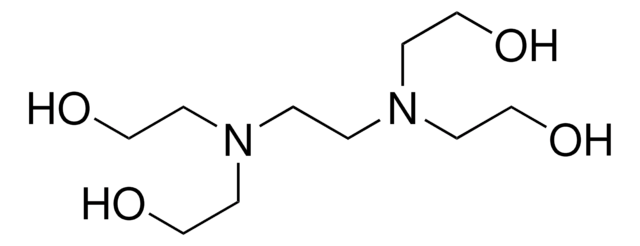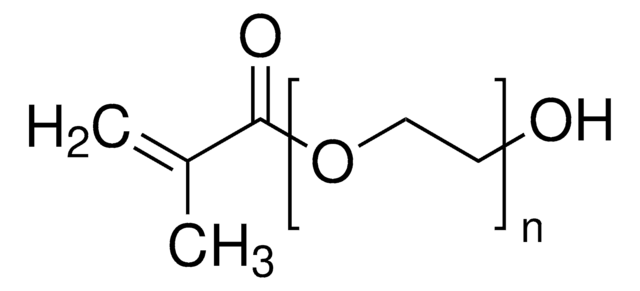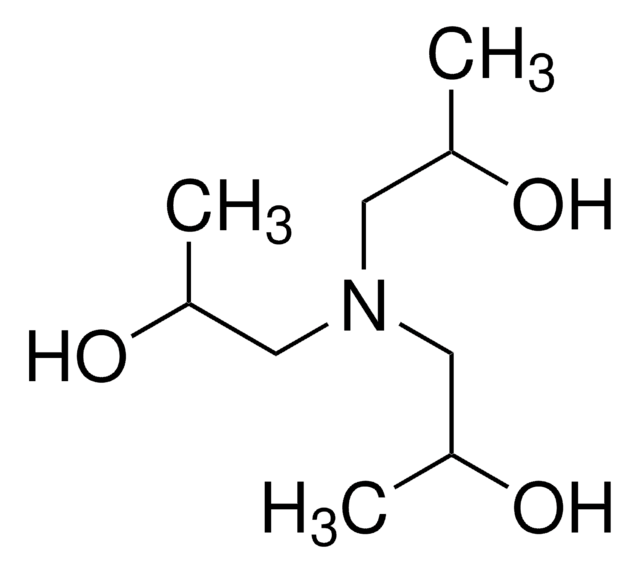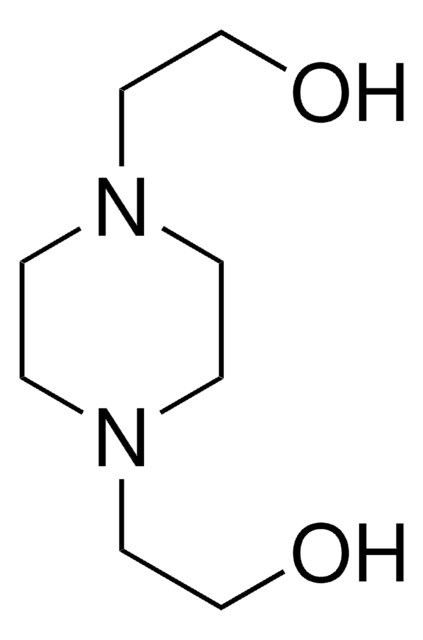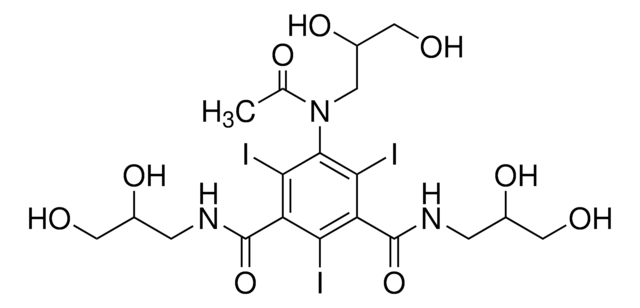122262
N,N,N′,N′-Tetrakis(2-Hydroxypropyl)ethylenediamine
98%
Synonym(s):
Edetol, Entprol, (Ethylenedinitrilo)tetra-2-propanol, Quadrol®
Sign Into View Organizational & Contract Pricing
All Photos(1)
About This Item
Linear Formula:
[CH3CH(OH)CH2]2NCH2CH2N[CH2CH(OH)CH3]2
CAS Number:
Molecular Weight:
292.41
Beilstein:
1781143
EC Number:
MDL number:
UNSPSC Code:
12162002
PubChem Substance ID:
NACRES:
NA.23
Recommended Products
vapor pressure
1 mmHg ( 20 °C)
Quality Level
Assay
98%
refractive index
n20/D 1.4812 (lit.)
bp
175-181 °C/0.8 mmHg (lit.)
density
1.013 g/mL at 25 °C (lit.)
SMILES string
CC(O)CN(CCN(CC(C)O)CC(C)O)CC(C)O
InChI
1S/C14H32N2O4/c1-11(17)7-15(8-12(2)18)5-6-16(9-13(3)19)10-14(4)20/h11-14,17-20H,5-10H2,1-4H3
InChI key
NSOXQYCFHDMMGV-UHFFFAOYSA-N
Related Categories
General description
N,N,N′,N′-Tetrakis(2-Hydroxypropyl)ethylenediamine (also known as Quadrol) is an ethylenediamine based monomer used in the production of polyurethane coatings, adhesives, cosmetics and personal care products. It can act as a chelating agent, due to the presence of its four hydroxyl groups, and a crosslinking agent, due to its two amino groups. It is widely used as a building block for polymers and copolymers, particularly those that are designed for use in UV-cross linkable polyurethane polymers, dendritic amino polymers, conducting polymers, inks, and coatings. Additionally, Quadrol is used in the production of resins, as well as in the manufacture of surfactants, plasticizers, and other chemical products.
Application
N,N,N′,N′-Tetrakis(2-Hydroxypropyl)ethylenediamine can be used as:
- A monomer in the synthesis of covalently cross-linked and amorphous shape memory polyurethane (SMPU) foams that are used in biomedical applications, which includes SMPU actuators for treating ischemic stroke, thrombus removal activated by laser light, self-deployable SMP neuronal electrodes, vascular stents, sutures in microsurgery, ocular implants, bandages, cell manipulation, and cell therapy.
- A precursor in the preparation of self-healing CFRPs (carbon fiber reinforced polymer) which are thermally responsive with excellent mechanical properties.
- A crosslinking agent to create a hydrogel that is biocompatible and supports the growth of neural cells. Hydrogels are specifically designed to mimic the properties of the extracellular matrix (ECM), in promoting cell proliferation. The purpose of the hydrogel in this context is to act as an extracellular matrix (ECM) substitute, providing a supportive environment for cell growth and guiding cell adhesion and outgrowth. This study investigates the potential of the peptide-modified channels to facilitate neural tissue engineering and enhance cell proliferation within the hydrogel-based scaffold.
Legal Information
Quadrol is a registered trademark of BASF Corporation
Signal Word
Warning
Hazard Statements
Precautionary Statements
Hazard Classifications
Eye Irrit. 2
Storage Class Code
10 - Combustible liquids
WGK
WGK 1
Flash Point(F)
411.8 °F - closed cup
Flash Point(C)
211 °C - closed cup
Personal Protective Equipment
dust mask type N95 (US), Eyeshields, Gloves
Choose from one of the most recent versions:
Already Own This Product?
Find documentation for the products that you have recently purchased in the Document Library.
Customers Also Viewed
Thermally responsive self-healing composites with continuous carbon fiber reinforcement
Yunseon Heo and Henry A. Sodano
Composites Science and Technology, 118, 244-250 (2015)
Tetsuhiro Kakimoto
Histochemistry and cell biology, 149(1), 97-103 (2017-10-21)
Histological analysis has been largely confined to two-dimensional analysis of thin tissue sections, hampering detailed understanding of three-dimensional cellular distribution in biological tissues. Tissue optical clearing methods enable three-dimensional histological analysis by rendering tissues transparent and suitable for microscopic detection
Ona Gyliene et al.
Journal of hazardous materials, 175(1-3), 452-459 (2009-11-10)
Decontamination of solutions containing Cu(II) complexes with tartrate, glycine and quadrol (N,N,N'N'-tetrakis(2-hydroxypropyl)ethylenediamine) using metallic iron depends on pH and proceeds best in mildly acidic solutions. Cu(II) is completely removed from all solutions containing the ligands investigated. The degree of ligand
Gökhan Orhan et al.
Journal of hazardous materials, 112(3), 261-267 (2004-08-11)
An electrochemical method was applied for the recovery of copper both from the spent solutions and from the rinse waters of electroless copper plating baths, containing copper sulfate, formaldehyde, quadrol, and NaOH. Experiments were conducted in a rotating packed cell
In vitro stimulation of macrophages by quadrol [N,N,N',N'-tetrakis(2-hydroxypropyl)ethylenediamine].
M V Bhide et al.
Journal of immunopharmacology, 7(3), 303-312 (1985-01-01)
Mouse peritoneal macrophages, when exposed to Quadrol [N,N,N',N'-tetrakis(2-hydroxypropyl)ethylenediamine] in vitro, show a dose dependent enhanced spreading over a four-hour period. In vitro Quadrol induced phagocytosis of polystyrene beads was found to be time and concentration dependent. The rate and extent
Our team of scientists has experience in all areas of research including Life Science, Material Science, Chemical Synthesis, Chromatography, Analytical and many others.
Contact Technical Service